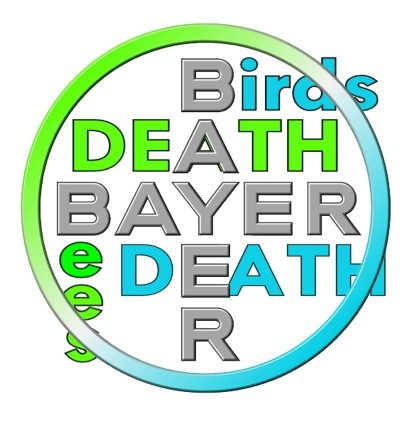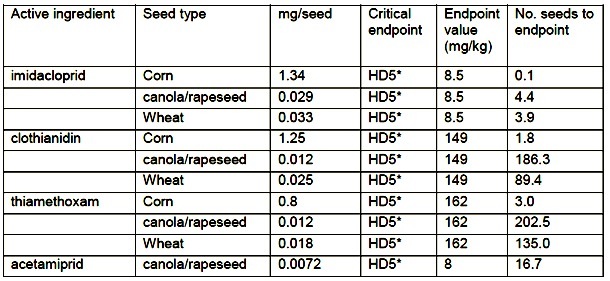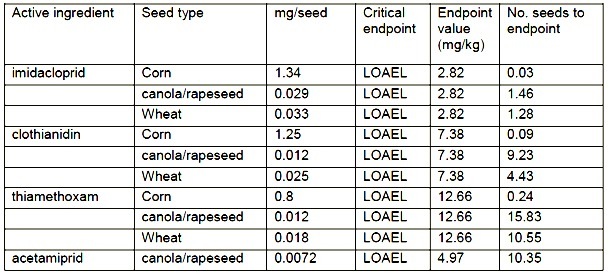April 17, 2013
The EPA is utterly derelict in its duty to regulate neurotoxic pesticides. Neonicotinoids are killing our primary pollinators, the bees. Less known, though, is that they’re also wiping out one of the real farmers’ best friends: birds. They’re on a devastating decline that can clearly be linked to the massive use of these deadly neurotoxins.
by Heidi Stevenson
 Not only bees are being killed by nerve poisoning pesticides, but birds are also disappearing. A report by the American Bird Conservancy has produced a devasting report outlining the disaster being wrought by neonicotinoids, neurotoxic pesticides, on birds.
Not only bees are being killed by nerve poisoning pesticides, but birds are also disappearing. A report by the American Bird Conservancy has produced a devasting report outlining the disaster being wrought by neonicotinoids, neurotoxic pesticides, on birds.
The report suggests that neurotoxic pesticides got a “very ‘soft ride’ through registration”, in spite of early recognition of their risks in the US, Canada, and UK. Even so, their toxicity to birds was underestimated.
Summary of Results
Many of the pesticide compounds that use neonicotinoids are intended for use on seeds, which is of particular concern to birds. As little as a single seed treated with neurotoxic pesticide is enough to kill an average-sized bird, such as a thrush.
To counter these concerns about birds, the industry has claimed that birds will not eat neonicotinoid-treated seeds, that they even find them repellant. The only cases in which birds have been shown to avoid such seeds, though, have been explainable as insecurity in the face of a new food or indigestion following eating a small amount. In other words, there is no legitimate evidence to support the industry’s claims.
One other concern regarding the neurotoxic pesticide’s effect on birds is that many species’ diets consist of insects, but many of the insects have been poisoned by these pesticides. Birds that eat them can be poisoned, and the lack of insects can also result in a lack of food.. A Dutch toxicologist, Henk Tennekes, has demonstrated that the loss of insect biomass in The Netherlands is behind the widespread declines of many birds.
The pesticides called neonicotinoids are neuro agents. They kill by causing paralysis. So-called Colony Collapse Disorder is a misnomer, as it’s been obvious since the earliest days of bee die-off awareness that the primary cause is these nerve agents.
They block the nervous system’s nicotinic acetylcholine receptor, which is found in the nervous systems of insects. ambhibians, reptiles, birds, and mammals. They persist in the environment; that is, they are slow to break down, so are likely to reach species other than the targeted insects.
It surely should not come as a surprise that neurotoxic pesticides are extremely dangerous, and that they are virtually guaranteed to kill insects other than those targeted, such as bees, or other animals that lively closely with and even feed on insects, such as amphibians and birds.
Specific Results on Birds
In terms of bird survival, the worst of the neonicotinoids are, by far, imidacloprid and clothianidin, both made primarily by Bayer. Below is a table reproduced from the American Bird Conservancy’s (ABC) report. It’s based on a 15 gram bird. A tit weighs about 11 grams, a wren 10 grams, an American blue jay 70 grams, and the quintessential songbird, a nightingale, weighs in at 21 grams.

Estimated number of seeds needing to be ingested by a 15 gram bird to achieve a 50% chance of lethality
(LD50) given sensitivity at the 5% tail of the bird distribution.
Notice that it takes a mere one-tenth of one imidacloprid-treated corn seed to kill half the medium-sized birds that ingest it. Let’s assume that we have 10 tits, each of which weighs less than the 15 grams assumed by this chart. If each tit were to eat one-tenth of one corn seed treated with imidaclopid, at least half of them would die! It would take close to 2 corn seeds treated with clothianidin to have the same effect.
Though other neurotoxic pesticides are not as bad, when you consider how much birds eat—often one-fourth to one-half their weight per day—it’s obvious that even these products are capable of harming the bird population.
Neonicotinoids don’t need to kill birds outright to destroy them. They also interfere with reproduction, and do so at much lower concentrations than required to cause death. The following table from the ABC study details how little is required to harm reproduction in birds.

Estimated number of seeds needing to be ingested by a 15 gram bird to achieve estimated reproductive effects.
It takes only three-hundreds of a corn seed treated with imidacloprid to damage reproduction in half of birds weighing 15 ounces. Though the effects are not seen so readily, the lesser quantities required to produce harm in reproduction clearly means that all neurotoxic pesticides must reduce bird numbers over generations.
Results on Aquatic Species
The direct effects of neonicotinoids on aquatic species, including fish, invertebrates, and algae, tend to be significantly less than those of other types of pesticides. However, there is evidence that the long term effects may be more insidious and subtle.
For example, low levels of neurotic pesticides are known to cause disorientation in bees. This doesn’t kill outright, but the behavioral changes can still result in death. The research in this area is limited, but disturbing. Low and short term exposure to these pesticides in mayflies causes inhibition in feeding. Predator-prey interactions have been shown to be affected.
The Environmental Protection Agency’s (EPA’s) earliest review of imidacloprid in 1994 expressed serious concern for aquatic life based on its mobility, solubility, and persistence. Their Environmental Fate and Effects Division (EFED) stated:
EFED has concluded that the available data on imidacloprid shows that the compound is mobile and persistent, has potential to leach to ground water, and also presents concerns for transport to surface water via runoff. In addition to the persistence issue, EFED also has a concern for imidacloprid residual carry-over to other crops after the previous year’s application.
These concerns proved to be well-founded. Unfortunately, the data to determine whether aquatic life is ultimately badly affected by neurotoxic pesticides doesn’t exist. We simply do not know the true effects of neonicotinoids on aquatic species.
Regulatory Inadequacy
Whether aquatic species are badly harmed by neonicotinoids, the fact is that the pollution of waterways and wetlands is proving disastrous for birds.The ABC’s study states:
Aerial insectivores, as a group, are currently experiencing widespread population declines. Their dependence on emergent insects is well known …
Aerial insectivores include, of course, birds, and there is no question that many species are on a very concerning decline. Other nonflying insectivores, though, may be in even worse shape. Frogs are known to be rapidly disappearing worldwide, along with other salamanders. How much of the decline is caused by neonicotinoids is not known.
The ABC’s report shows inconsistencies in regulation and outdated regulatory methods. They state:
Simply put, EPA has not been heeding the warnings of its own toxicologists. Internal Agency reviews voice major concerns about neonicotinoid risks, particularly with respect to developmental and reproductive toxicity. Their official cautions would be even more dire if EPA scientists went beyond their antiquated protocols and correctlyassessed the full extent of the impacts.
Further, the EPA has underestimated the risk of imidacloprid on aquatic species by at least a thousandfold. They ignore data provided in peer-reviewed research. They have used a single test species to determine toxicity, but the species they’re using, Daphnia magna, the water flea, is known to be highly resistant to neurotoxic pesticides.
A single corn seed treated with imidacloprid is enough to kill a blue jay-sized bird, and a small fraction of a treated seed can disrupt reproduction.
There is no known biomarker to identify whether a bird’s, or other animal’s, death is a result of neonicotinoids. ABC states:
It is astonishing that EPA would allow a pesticide to be used in hundreds of products without ever requiring the registrant to develop the tools needed to diagnose poisoned wildlife. It would be relatively simple to create a binding assay for the neural receptor which is affected by this class of insecticides.
The EPA’s own reporting requirements for suspected neonicotinoid deaths are so minimal that they cannot possibly determine realistic rates of wildlife death from them.
For these and other reasons not delineated here, the ABC recommends that the EPA:
Suspend all applications of neonicotinoids pending independent review of these products’ effects on birds, terrestrial and aquatic invertebrates, and other wildlife.
Expand its re-registration review of neonicotinoids beyond bees to include birds, aquatic invertebrates, and other wildlife.
Ban the use of neonicotinoids as seed treatments.
Require that registrants of acutely toxic pesticides develop the tools necessary to diagnose poisoned birds and other wildlife.
What is the EPA waiting for? Is it really necessary for the last robin to die before these environment and life-destroying neurotoxins are removed from the market? Is there no consideration for the fact that two of real farmers’ best friends in pest elimination, birds and bees, are disappearing? The situation is desperate, and there is no possible legitimate excuse for allowing the continued use of these poisons.
Sources:
- The Impact of the Nation’s Most Widely Used Insecticides on Birds; American Bird Conservancy; Dr. Pierre Mineau and Cynthia Palmer






Leave a comment